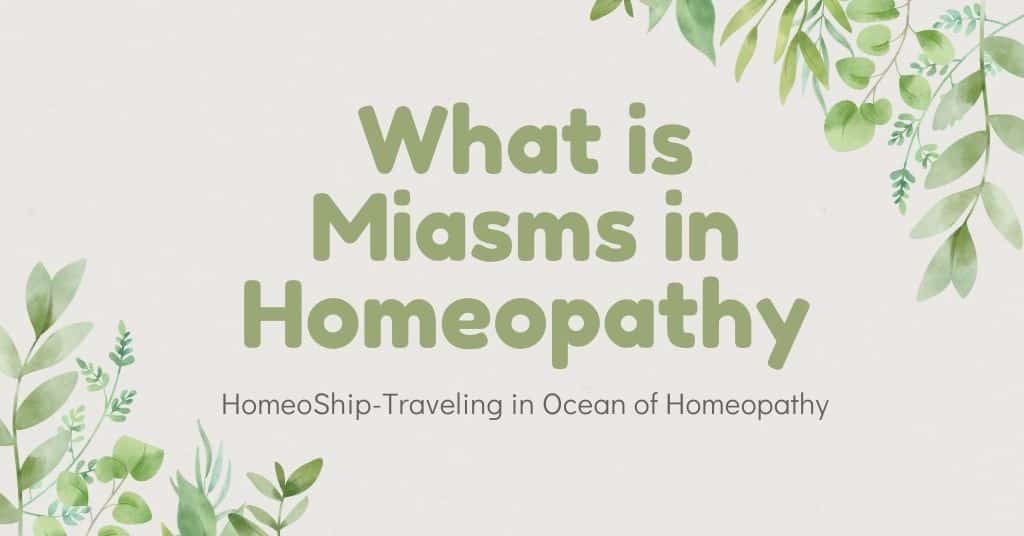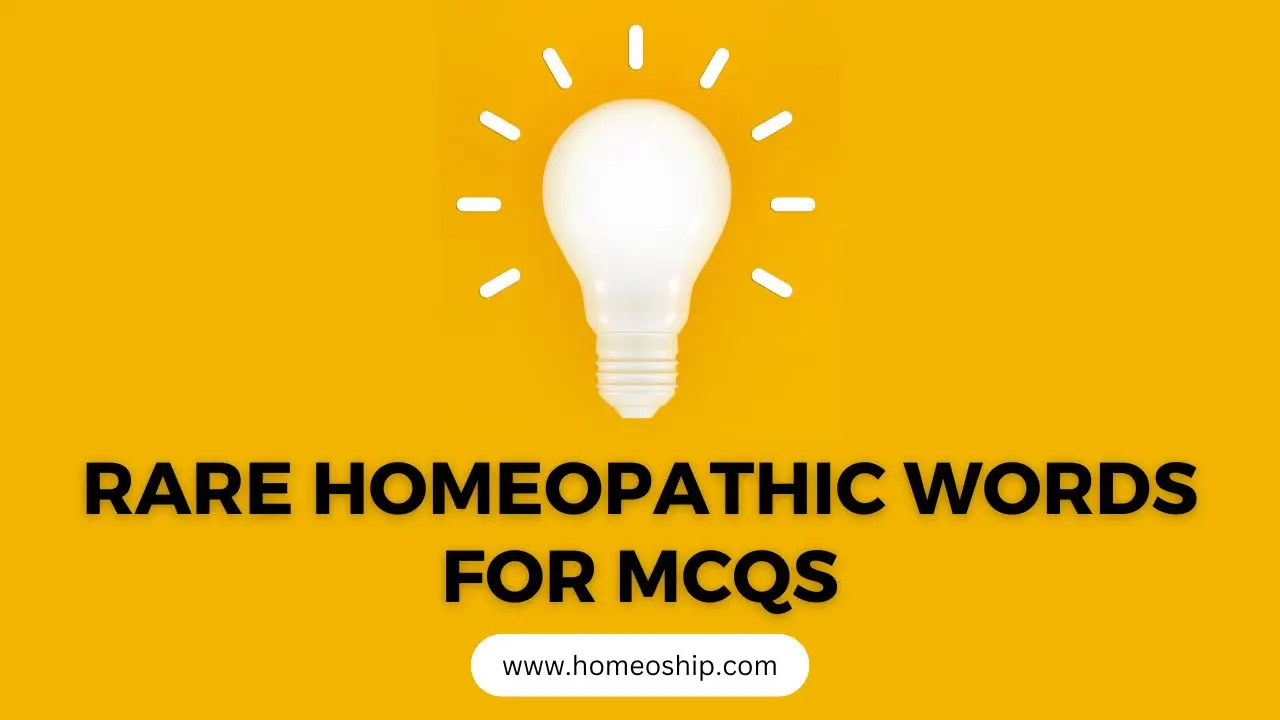Miasms are dynamic disease-producing powers that pollute human organisms and produce all possible diseases. The word “miasm” has originated from the Greek word, “miasma”, which has multiple means:
1. Polluting exhalations
2. Malarial poison
3. Morbific emanations
4. Purulent organic matter
5. Effluvia arising from the bodies of the patients

But Hahnemann used the term “miasm” with a specific meaning. He used this word to indicate a syndrome when he stated the miasmatic manifestation.
Stuart Close says, “Miasms according to Hahnemann and most of his followers, an infecting agent, and a cause of disease”.
Sir John Weir remarks in his work, ‘Science and art of Homoeopathy’, “By miasm Hahnemann meant germ disease”.
Hahnemann’s discovery of acute miasms only followed that of chronic miasms. In his fourth edition of Organon, he improved his “clinical classification of diseases” as explained by him in § 5 and 72. In his “Chronic diseases”, Hahnemann says “All miasmatic maladies….. which show peculiar local ailments on the skin are always present as internal maladies in the system before they show their local symptoms externally upon the skin; but only in acute diseases, after taking their course, through a number of days, the local symptom together with the internal disease is wont to disappear which then leaves the body free from both.
In chronic miasms, however, the outer local symptom may either be driven from the skin or may disappear of itself, while the internal disease, if uncured, neither wholly nor in part ever leaves the system, On the contrary, it continually increases with the years, unless healed by art.”
Any miasm including both acute diseases as well as the chronic miasmatic disease develops in the following “three important movements”:
1. First movement: The time of infection / the mode of infection.
2. Second movement: (internal development) The period of time taken by the disease to penetrate until it develops fully within.
3. Third movement: Manifestation of the external disease, breaking out of the external ailment, as proof of the development of internal miasmatic malady. The infection with both acute and chronic miasms takes place without a doubt in “one single movement”. That movement is the most favorable one for infection.
The article you must read before understanding miasm in detail.
- Classification of Chronic Disease in Homeopathy
- Hahnemann’s Classification of Diseases in Homeopathy
Types of Miasms
Finally, the miasms have been classified into 4 types:
1. Acute miasm: This is again of 2 types:
i. Recurrent type: Example: cholera, plague, etc.
ii. Non-recurrent miasm or fixed miasm: Example: smallpox, whooping cough, etc.
2. Half acute miasm: Miasm of hydrophobia or rabies
3. Accessory miasm of cow-pox vaccine
4. Chronic miasm: This is again of 2 types:
i. Nonvenereal psora
ii. Venereal miasms syphilis and sycosis
Acute Miasm
Acute miasm is a dynamic disease-causing agent which causes specific infectious diseases having almost fixed manifestations. These are of 2 types:
1. Recurrent acute miasm: Those types of acute miasms that recur in the same manner more than once in a lifetime of a particular person. Example: Asiatic cholera, the plague of Levant, yellow fever of the seacoast, etc.
2. Non-recurrent acute miasm: This is also called as fixed miasm. These types of acute miasms are those which attack a person only once in a lifetime, are called the non-recurrent or fixed miasms. Example: smallpox, whooping cough, etc.

Half spiritual miasm
This was explained by Hahnemann in his book “Chronic diseases”. The miasm of measles, scarlet fever, pox, etc is called the half spiritual miasms because after completing their parasitical existence in the system for some period they die out leaving the organism to recover soon if the patient does not die by the time.
The peculiar characteristic of the half spiritual miasm is that, after they have penetrated the vital force in the first movement of contagion, they produce the disease in their own way. Then the parasites quickly grow within it and usually develop a peculiar fever after producing a mature cutaneous eruption (fruit), which in turn is capable of producing its miasm. Finally, they die out leaving the organism free to recovery.
Half Acute Miasm
The miasm of the hydrophobia has been termed as half acute miasm. The miasm takes effect the moment a person gets bitten by a mad dog. The poison of this miasm gets communicated to the nearest nerves. As soon as the malady develops inside the organism, the madness breaks out as an acute, quickly fatal disease. The development of the nervous infection and the spread of disease infection internally require at least several days to often many weeks.
The infection took place irreversibly at the moment of contagion. Experience shows that immediate cutting and amputating of the infected part does not protect from the progression of the disease that develops from within. This does not help the body in any way from preventing the development of hydrophobia. The other means like cleaning, cauterizing, and suppurating the wound of the bite cannot protect from hydrophobia.
Accessory Miasm
Apart from the protective matter, the lymph of the inoculated cow-pox contains an additional miasm by which it produces a characteristic cutaneous eruption on the skin. This additional miasm, Hahnemann called the accessory miasm. The lymph of inoculated cow-pox, besides the protective matter, contains a contagion capable of producing a general; cutaneous eruption of different nature.
This usually consists of small, dry pimples resting on the small red areola, frequently intermingled with round red cutaneous spot, and is often accompanied by most violent itching. In many children, the eruption actually appears several days before, but more frequently after the red areola of cowpox and vanishes in few days leaving behind small red and hard spots on the skin. It was testified by many observers that because of its similarity, this accessory miasm, the inoculated cow-pox cures perfectly and permanently in a homeopathic manner, similar cutaneous eruptions in children, often very low standing and of very troublesome character.

Chronic Miasm
Chronic miasms are the fundamental causes of all the disease. They produce the true or the natural miasmatic chronic diseases. They thus predispose human beings to various types of acute disease also.
Hahnemann identified 3 types of chronic miasms:
1. Psora
2. Syphilis
3. Sycosis
The chronic miasms go on worsening inside in spite of the best corporeal and mental regimen. They torment the patient till the end of his life. They are ineradicable by the vital force alone without the aid of the dynamic homeopathic medicines. They also have the tendency to transfer from one generation to the other generation.
Hahnemann’s approach to the clinical study of the patient is in the syndromic approach to identify the predominant miasm that is present in the patient and causing the diseases and not in nosological diagnosis of the disease.
Let’s discuss Psora Syphilis and Sycosis in different posts as they are deep topics you should have detailed knowledge. Follow us on our Homeoship Instagram account for more information.



